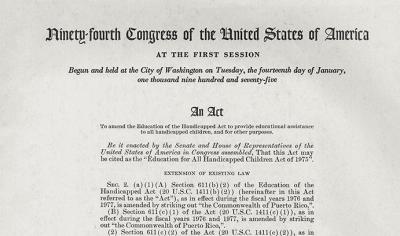IDEA's Impact
 The Individuals with Disabilities Education Act changed the landscape of schooling for children with special needs like no law before or since.
The Individuals with Disabilities Education Act changed the landscape of schooling for children with special needs like no law before or since.
When Congress enacted it in 1975, Public Law 94-142—originally named the Education for All Handicapped Children Act—mandated that children with disabilities were entitled to a "free, appropriate public education" in the "least restrictive environment."
When possible, they should be educated with students in regular schools. Before IDEA, children with disabilities were often segregated or warehoused in state institutions with no guarantee of proper assessments or schooling. That meant more than a million children had no access to public schools. Some states specifically barred those with certain disabilities from attending regular schools, including those who were deaf or blind.
Central to the law is the Individualized Education Plan or IEP. Teams of teachers, administrators, counselors and parents come up with a strategy for what supports and accommodations a student will need to meet educational goals. It's up to the school to follow that plan.
"I have signed this bill very reluctantly. It promises more than the Federal Government can deliver and its good intentions could be thwarted by the many unwise provisions it contains." —Gerald R. Ford
Still, the effort to mainstream students hasn't been free of controversy. While advocacy groups push for more inclusion, the parents of some special needs students have fought to obtain placements for their children in special schools, which are sometimes more expensive than regular schools. School districts complain that federal funding for special education hasn't kept up with actual costs.
Inclusion also has tested teachers, who now must manage classrooms for students with a wide array of abilities and behaviors.
But IDEA's impact has opened the door to opportunities once out of reach for many disabled people. Special needs students who went through school since the implementation of IDEA are twice as likely to have jobs than older adults with similar disabilities who didn't benefit from the law.
Story by Margie Peterson